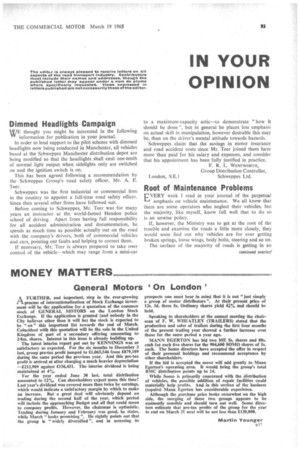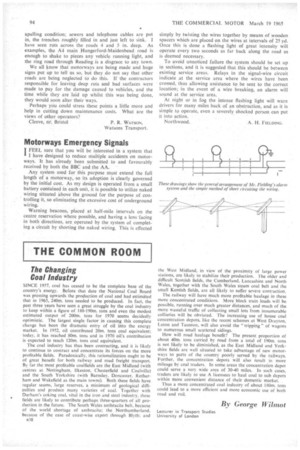IN YOUR OPINION
Page 95

Page 96

If you've noticed an error in this article please click here to report it so we can fix it.
Dimmed Headlights Campaign
WE thought you might be interested in the following " information for publication in your journal.
In order to lend support to the pilot scheme with dimmed headlights now being conducted in Manchester, all vehicles based at the Schweppes Manchester distribution depot are being modified so that the headlights shall emit one-tenth of normal light output when sidelights only are switched on and the ignition switch is on.
This has been agreed following a recommendation by the, Schweppes Group's road safety officer, Mr. A. E. Teer.
• Schweppes was the first industrial or commercial firm in the country to appoint a full-time road safety officer. Since then several other firms have followed suit.
Before coming to Schweppes, Mr. Teer was for many years an instructor at the world-famed Hendon police school of driving. Apart from having full responsibility for all accident administration and documentation, he spends as much time as possible actually out on the road with the company's drivers, both of commercial vehicles and cars, pointing out faults and helping to correct them.
If necessary, Mr. Teer is always prepared to take over control of the vehicle— which may range from a mini-car
to a maximum-capacity artic—to demonstrate "how it should be done ", but in general he places less emphasis on actual skill in manipulation, however desirable this may be, than on the driver's mental attitude towards hazards. Schweppes claim that the savings in motor insurance and road accident costs since Mr. Teer joined them have more than paid for his salary and expenses, and consider that his appointment has been fully justified in practice. F. R. L. WENTWORTH, Group Distribution Controller,
London, S.E.1 Schweppes Ltd.
Root of Maintenance Problems
EVERY week I read in your journal of the perpetual emphasis on vehicle maintenance. We all know that there are some operators who neglect their vehicles, but the majority, like myself, know full well that to do so is an unwise policy.
If, however, the Ministry was to get at the root of the trouble and examine the roads a little more closely, they would soon find out why vehicles are for ever getting broken springs, loose wings, body bolts, steering and so on.
• The surface of the majority of roads is getting in an
apalling condition; sewers and telephone cables are put in, the trenches roughly filled in and just left to sink. I have seen ruts across the roads 4 and 5 in. deep. As examples, the A4 main Hungerford-Maidenhead road is enough to shake to pieces any vehicle running light, and the ring road through Reading is a disgrace to any town. We all know that motorways are being made and huge signs put up to tell us so, but they do not say that other roads are being neglected to do this. If -the contractors responsible for leaving deep ruts and bad surfaces were made to pay for the damage caused to vehicles, and the time while they are laid up whilst this was being done, they would soon alter their ways. Perhaps you could stress these points a little more and help in cutting down maintenance costs. What are the views of other operators?
Cleeve, nr, Bristol P. R. WATSON, Watsons Transport.
Motorways Emergency Signals
1 FEEL sure that you will be interested in a system that I I have designed to reduce multiple accidents on motorways. It has already been submitted to and favourably received by both the BBC and the AA. Any system used for this purpose must extend the full length of a motorway,so its adoption is clearly governed by the initial cost. As my design is operated from a small battery contained in each unit, it is possible to utilize naked wiring situated above the ground for the purpose of controlling it, so eliminating the excessive cost of underground wiring. Warning beacons, placed at half-mile intervals on the centre reservation where possible, and having a lens facing in both directions, are operated by the system of completing a circuit by shorting the naked wiring. This is effected simply by twisting the wires together by means of wooden spacers which are placed on the wires at intervals of 25 yd. Once this is done a flashing light of great intensity will operate every two seconds as far back along the road as is deemed necessary. To avoid unnoticed failure the system should be set up in sections, and it is suggested that this should be between existing service• areas. Relays in the signal-wire circuit indicate at the service area where the wires have been crossed, thus allowing assistance to be sent to the correct location; in the event of a wire breaking, an alarm will sound at the service area. At night or in fog the intense flashing light will warn drivers for many miles back of an obstruction, and as it is simple to operate, even a severely shocked person can put it into action.
Northwood.
A. H. FIELDING.












































































































































